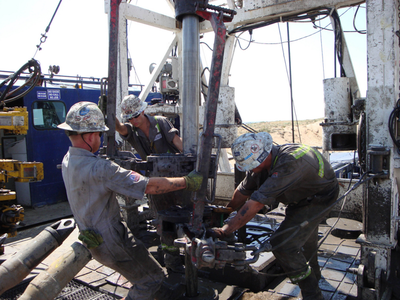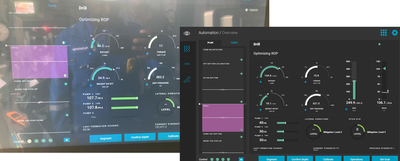Drilling Automation at Schlumberger
How a team of KCL researchers saves a Fortune 500 company a fortune in cost and time
Profs Maria Fox and Derek Long have built an AI planning tool for global energy company Schlumberger that makes drilling safer, faster and more environmentally friendly. The tool is proving a huge success – and is on its way to become a new global industry standard.
Introduction
In the classic Western drama Boom Town, the two wildcatters Clark Gable and Spencer Tracy quickly cobble some equipment together to develop their own oil field – and get rich fast. On the rigs, good fortune and a good nose are no less important than hard work. Of course, the reality of oil and gas drilling is a much more complex and methodological affair. It requires highly skilled and experienced drillers to work in challenging, noisy environments that make automation difficult. Putting their deep expertise in temporal planning into practice, a team of KCL Informatics researchers has developed an AI planning tool that radically outperforms any previous attempts at automated drilling in the oil industry.
Background: you know the drill – or do you?
Oil drilling is hard, laborious, and very demanding work. Drilling down into the ground is very unlike drilling horizontally into a wall where pushing harder usually means better progress. The sheer weight of the long and heavy stretches of metal pipes that make up the drill string requires engineers to hold back and finely balance the weight so that there’s not too much downward pressure on the drill top to crush it. Drilling too fast is no good either. Only experienced drillers manage to get the relative weight and speed of rotation right to make good and steady progress.

In principle, the drilling process cries out for automation: drill down the length of a standard pipe, secure the well, screw another pipe to the top and drill down further. Previous attempts at automation involved writing static scripts that would tell the system what to do. But the engineers quickly realised that it wouldn’t work. ‘The joke at the time was that it took more people on the rig to drill automatically than it took to drill manually, because you had all the drilling crew and then you also had to have the software engineers to repair the software every time it failed’, Prof Long recalls. While the drilling process seems repetitive from a safe distance, in practice it’s always very different.
Things get even more complicated once an oil or gas reservoir is reached. Sandwiched between rock formations, the reservoir must be drilled into horizontally. ‘Just imagine trying to drill around a corner with a hand drill into a wall’, Prof Long continues, ‘it’s just very difficult’. Communication between devices is not exactly easy either: drowned in a lot of mud and fluid means that the drill can only communicate downhole to surface via Mud Pulse Telemetry at a snail pace of one bit per second. Things can go wrong all the time, which inevitably meant that new conditions had to be added constantly to the script – which each new problem encountered along the way it got bigger and bigger. ‘The script was just becoming an uncontrollable spaghetti mess’, Prof Long adds. An entirely different approach was needed.
What exactly did the team do?
Upon joining KCL Informatics in 2011, Profs Fox and Long started to apply their expertise in temporal planning to solving one the biggest challenges in wellbore construction: how can a system be automated if it needs to adapt constantly to challenging environmental conditions? Their solution: a dynamic, domain-agnostic planning tool that lends itself to being deployed across a whole range of different rock environments.
They’ve built an AI planner that collects a set of available actions for a given domain, describes an initial state and a goal. The tool then works out which actions exactly are best for making as much headway as possible towards that goal. Essentially, plans are interpreted as goal instructions in controlled systems such as a wellbore. The team would draw on their influential research in Robotics to achieve this. They’d also developed their own modelling language for building the planner.
At KCL Informatics, the big achievement was to link plans to execution: rather than grinding to a halt when it encounters a new problem, the planner responds to failure with replanning wherever possible. To do this, the team had found a clever way to connect the flexible domain-agnostic planner, which can be applied universally, to an external solver that captures the nitty-gritty specifics of the actual structure the system finds itself in. The work has culminated in several patent applications and a bespoke plan execution language for Schlumberger. KCL was an excellent place to do this work, the team says. ‘It really was the generous support of the Department that allowed that to happen’, Prof Long comments on his engagement activity with Schlumberger.

The company first trialled the new planner in 2016. ‘They let the driller in charge of the system with the software on board, so the thing was just automatically running overnight’, Prof Long recalls. ‘When they arrived in the morning the driller said, can I just keep using it until the end of my shift, because it’s making my life so much easier’. And this was just the beginning. ‘The real step change in our approach to automate the highly dynamic and uncertain drilling process started when we engaged Derek and Maria’, Schlumberger’s Vice President for Technology Development (Well Construction) points out.
The impact so far: all is well that ends well
The team’s AI planner has quickly established itself as the core technology for all of Schlumberger’s automation technology products for the design and development of wells. A lot of oil companies have been trying to introduce more automation into their processes for some time but only Schlumberger has come this far. The planner now sits at the heart of Schlumberger’s proprietary DrillOps software. DrillOps has already been deployed at nearly 30 rigs across Saudi Arabia, Italy and North America. The company calculates that automated drilling has surpassed 63,000 ft drilled in Saudi Arabia alone, improving penetration rates by 17%.
This is possible because, curiously, automated drilling tends to be more efficient as it’s steadier and more conservative than human drilling. ‘Human drillers often drill certain parts of the hole faster because they’ll push the tool harder. But actually, that’s part of the reason that they end up not being as efficient as the autonomous system, because they take risks without fully understanding the implications of the risks that they take’, Prof Long explains. The planner also solves problems around competitive instincts that encourage human drillers to try to do too much too fast, only to leave colleagues for the shifts that follow with more challenges to solve.
In its 2020 Q2 Financial Report, Schlumberger highlights the considerable advantages that the planner has in store. DrillOps offers a ‘plug and play capability’ that allows rigs ‘to operate at peak performance’ at all stages of the drilling plan. Schlumberger’s Science and Technology Manager (Automation and Planning) says: ‘Automation, through plan execution enabled by the work of Fox and Long, creates consistency of operations, which drives safety, reduces time-to-target, and the minimisation of environmental footprint’. Estimates suggest that the AI planner saves Schlumberger a whopping $100m annually. But it’s not all about cost savings. Thanks to the planner the company is well ahead of the curve. ‘I think that there is a much bigger value for them, which has to do with competitive edge’, Prof Long adds.
Looking ahead: the next steps
Drilling automation will be paramount for the industry to recover post-Covid. Schlumberger presently plans to extend DrillOps operations to a hundred rigs in the near future. They’ve also partnered up with Norway’s NOV to give their automation solutions for wellbore constructions a big push. Further collaborations with big Chinese and US players are also being developed. And Schlumberger investigate he integration of the AI planner with other parts of its business too, such as wireline operations.
The company has high plans for the technology developed by Profs Fox and Long. For their Vice President for Technology Development (Well Construction), the ‘goal with this product is to make it available to the wider industry and become the industry standard for drilling automation’. The AI planner is having a big impact on making drilling not just faster and more cost-effective but safer and more environmentally friendly too.
This story was written by Juljan Krause, a professional science writer and final-year PhD Researcher in quantum communication.